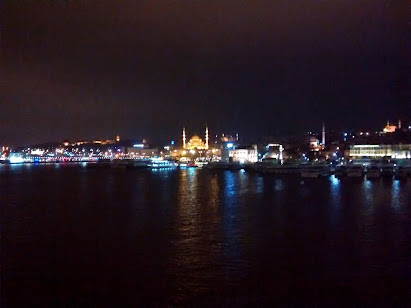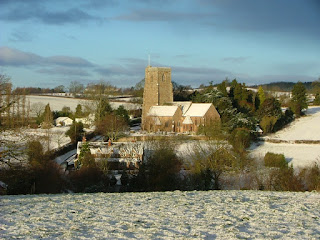Santiago de Compostela
Saturday 27th February
With Compostela in sight below us, we join the obligatory photo opportunity by the pilgrims' statue below the top of the Monte do Gozo, the Hill of Joy. Indeed, the feeling of euphoria is contagious and everyone is babbling excitedly in the morning sunshine. The two pilgrims are pointing towards the towers of the cathedral, 4km away.
Following their directions, we go into the Oficina de Acogida al Peregrino to get the final stamp for our passports and pick up our certificates. It is busy. The people in the office are welcoming, they smile and nod, but they see so many pilgrims all they want to do is the paperwork and move on to the next so they have no curiosity about us. It is a bit of an anticlimax.
The carved romanesque Cathedral portico is a magnificent work of art on its own. Passing under it we find the ornate, gilded altar gleaming luxuriously in the lamplight. Janet, who has been here on a feast day, tells us about the Botafumeiro:
'The censer is under the main dome and stands up to shoulder height on the men who bring in the rope to swing it. There are eight parts to the bottom end of the rope so each of the men (they wear calf length crimson robes and trainers) seizes one part and they haul the botafumeiro on a pulley to head height. It is a massive, tubby piece of silver weighing 80kg which, once the incense and charcoal are lit, creates clouds of smoke. Hauling it up and down starts a bit of momentum but another man steps forward and gives it a push which sets it swinging properly. They pull the censer up and back until it is swinging furiously, nearly hitting the transept roof on either side and flying through the crossing at head height. At this moment the organ comes crashing in fortissimo which makes the hairs on the back of your neck stand up! The smoke billows out on its traverse, which is meant to cover the smell of the hot and sweaty pilgrims.'
Janet smiles ruefully and adds: 'At this moment one of our party, who happened to be an engineer, looked at the frayed rope and exited the cathedral!'
Since the Middle Ages the people of Santiago have believed that St James is buried here and we queue to climb the steps to touch the mantle of his statue. From there we turn into the crypt where there is a a hush of prayer. The silver casket stands behind a gate at the end of a stone passage. It is easy to see that this is a highly spiritual moment for many people in the queue while for others it is a tick in the box. What would James and Jesus make of so much opulence?
We also visit the Benedictine Monasterio of San Martino Pinario, an imposing edifice which speaks of the wealth accrued from being central to a place of pilgrimage. It is wide and airy, a restful place.
Sunday 28th
It's time to go home.
We'll return by the northern Camino route, Oviedo, Santander, Bilbao, San Sebastian, along the Basque coast. This is said to be the foodie route so today we are heading for Oviedo in the principality of Asturias. We ramble through forests and across the fields, in no hurry today, enjoying the spring flowers and the birdsong. The village houses are built of stone with wavy terracotta pantile rooves. Time seems to have stood still here. In the town of Lugo we discover with delight the beautifully maintained and much loved path that runs along the top of the massive Roman walls where the local turn out for their Sunday stroll. We get a first-floor view of the roofscape of the town.
It is easy walking with views of the mountains to our right, a good road almost completely traffic free.
'Probably built with EU money.'
After Grandas we follow the Arroyo Grandas valley and climb steeply onto flat topped hills that roll away on either side like green velvet shoulders. Still no traffic. We exchange a ¡Hola! with a lone cyclist, cross a dam (which might explain the quality of the road) and climb again onto what feels like the roof of the Cantabrian mountains.
Oviedo has great charm. In the evening we stroll into the historic La Lechera quarter and find a delicious seafood meal on the Plaza Porlier with mejillones, mussels, local cheese and cider. Our waiter is rightly proud of the regional produce.
'¡Buen provecho!'
Mmmmm. Happy pilgrims.





Comments
Post a Comment